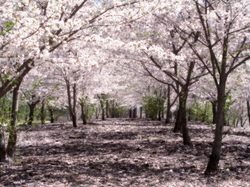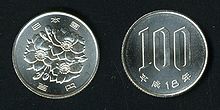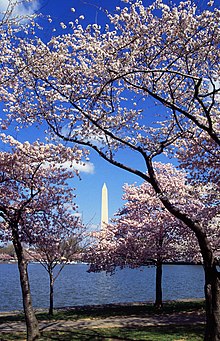Cherry blossom: Difference between revisions
m Reverted edits by 24.83.112.212 to last version by Asterism (HG) |
|||
| Line 34: | Line 34: | ||
[[image:100JPY.JPG|thumb|left|A 100 [[yen]] coin depicting Cherry Blossom ]] |
[[image:100JPY.JPG|thumb|left|A 100 [[yen]] coin depicting Cherry Blossom ]] |
||
[[Image:Ornamental Cherry Tree In Full Bloom.JPG|275px|right|thumb|Flowering Cherry Tree]] |
[[Image:Ornamental Cherry Tree In Full Bloom.JPG|275px|right|thumb|Flowering Cherry Tree]] |
||
Whereas in China the cherry blossom symbolizes feminine beauty, the feminine principle, or love in the language of [[herb]]s, in Japan the cherry blossoms are believed to exemplify the transient nature of life, because of their short blooming times. Cherry blossoms also symbolize clouds due to their nature of blooming en masse, besides being an enduring metaphor for the ephemeral nature of life,<ref name=khoon>Choy Lee, Khoon. ''Japan--between Myth and Reality''. 1995, page 142.</ref> an aspect of Japanese cultural tradition that is often associated with Buddhistic influence,<ref>Young, John and Nakajima-Okano, Kimiko. ''Learn Japanese: New College Text''. 1985, page 268.</ref> and which is embodied in the concept of ''[[mono no aware]]''.<ref name=Slaymaker>Slaymaker, Douglas. ''The Body in Postwar Japanese Fiction''. 2004, page 122.</ref> The association of the Sakura with ''mono no aware'' dates back to 18th-century scholar [[Motoori Norinaga]].<ref name=Slaymaker /> The transience of the blossoms, the extreme beauty and quick death, has often been associated with mortality;<ref name=khoon /> for this reason, Sakura are richly symbolic, and have been utilized often in [[Japanese art]], [[manga]], [[anime]], and film, as well as at musical performances for ambient effect. The band [[Kagrra]], which is associated with the [[visual kei]] movement, is an example of this latter phenomenon. There is at least one popular [[folk song]], originally meant for the [[shakuhachi]] (bamboo flute), titled "[[Sakura (folk song)|Sakura]]", and several [[j-pop|pop songs]]. The flower is also represented on all manner of consumer goods in Japan, including [[kimono]], stationery, and dishware. |
|||
Sakura, or Cherry Blossom is an omen of good fortune and is also an emblem of love, affection and represents spring. Cherry blossoms are an enduring metaphor for the fleeting nature of life, and as such are frequently depicted in art. |
Sakura, or Cherry Blossom is an omen of good fortune and is also an emblem of love, affection and represents spring. Cherry blossoms are an enduring metaphor for the fleeting nature of life, and as such are frequently depicted in art. |
||
Revision as of 15:17, 3 December 2008
| Sakura | |
|---|---|

| |
| Scientific classification | |
| Kingdom: | |
| Division: | |
| Class: | |
| Order: | |
| Family: | |
| Subfamily: | |
| Genus: | |
| Species | |
|
Prunus serrulata (Prunus jamasakura) | |

Sakura (Japanese kanji : 桜 or 櫻; katakana: サクラ; hiragana: さくら) is the Japanese name for cherry trees, and their blossoms. In English, the word "sakura" is equivalent to the Japanese flowering cherry,[1] and their blossoms are commonly called cherry blossoms. Cherry fruit (known in Japanese as sakuranbo) comes from another species of tree.
Natural history
Sakura is indigenous to many Asian states including: China, India, Japan, and Korea. Japan has a wide variety of sakura; well over 200 cultivars can be found there.[2]
Flower viewing
During the Heian Period (794–1191), the Japanese nobility sought to emulate many practices from China,[citation needed] including the social phenomenon of flower viewing (hanami: 花見), where the imperial households, poets, singers, and other aristocrats would gather and celebrate under the blossoms. In Japan, cherry trees were planted and cultivated for their beauty, for the adornment of the grounds of the nobility of Kyoto, at least as early as 794.[3] In China, the ume "plum" tree (actually a species of apricot) was held in highest regard, but by the middle of the ninth century, the sakura had replaced the plum as the favored species in Japan.[citation needed]

Every year the Japanese Meteorological Agency and the public track the sakura zensen (cherry-blossom front) as it moves northward up the archipelago with the approach of warmer weather via nightly forecasts following the weather segment of news programs. The blossoming begins in Okinawa in January and typically reaches Kyoto and Tokyo at the end of March or the beginning of April. It proceeds into areas at the higher altitudes and northward, arriving in Hokkaidō a few weeks later. Japanese pay close attention to these forecasts and turn out in large numbers at parks, shrines, and temples with family and friends to hold flower-viewing parties. Hanami festivals celebrate the beauty of the sakura and for many are a chance to relax and enjoy the beautiful view. The custom of hanami dates back many centuries in Japan: the eighth-century chronicle Nihon Shoki (日本書紀) records hanami festivals being held as early as the third century CE.
Most Japanese schools and public buildings have sakura trees outside of them. Since the fiscal and school year both begin in April, in many parts of Honshū, the first day of work or school coincides with the cherry blossom season.
Symbolism


Sakura, or Cherry Blossom is an omen of good fortune and is also an emblem of love, affection and represents spring. Cherry blossoms are an enduring metaphor for the fleeting nature of life, and as such are frequently depicted in art.

During World War II, the sakura was used to motivate and manipulate the Japanese people, to stoke nationalism and militarism among the populace.[4][5] Japanese pilots would paint them on the sides of their planes before embarking on a suicide mission, or even take branches of the trees with them on their missions.[4] A cherry blossom painted on the side of the bomber symbolized the intensity and ephemerality of life;[6] in this way, the aesthetic association was altered such that falling cherry petals came to represent the sacrifice of youth in suicide missions to honor the emperor.[4] The government even encouraged the people to believe that the souls of downed warriors were reincarnated in the blossoms.[4]
In its colonial enterprises, imperial Japan often planted cherry trees as a means of "claiming occupied territory as Japanese space".[5] For this reason, the symbolic import of the cherry trees is quite different in Korea, where the trees at Seoul's Gyeongbok Palace were cut down to celebrate the fiftieth anniversary of liberation from Japanese colonial rule.[5]
Varieties

The most popular variety of sakura in Japan is the Somei Yoshino. Its flowers are nearly pure white, tinged with the palest pink, especially near the stem. They bloom and usually fall within a week, before the leaves come out. Therefore, the trees look nearly white from top to bottom. The variety takes its name from the village of Somei (now part of Toshima in Tokyo). It was developed in the mid- to late-19th century at the end of the Edo period and the beginning of the Meiji period. The Somei Yoshino is so widely associated with cherry blossoms that jidaigeki and other works of fiction often depict the variety in the Edo period or earlier; such depictions are anachronisms.
Winter sakura (fuyuzakura/Prunus subhirtella autumnalis) begins to bloom in the fall and continues blooming sporadically throughout the winter. It is said to be a cross between Tokyo Higan cherry (edohiganzakura/P. incisa) and Mamezakura/P. pendula. [7]
Other categories include yamazakura, yaezakura, and shidarezakura. The yaezakura have large flowers, thick with rich pink petals. The shidarezakura, or weeping cherry, has branches that fall like those of a weeping willow, bearing cascades of pink flowers.
Cherry blossom in other countries
Philippines
A province in Western Philippines, Palawan, serves as home to an endemic Palawan Cherry Blossoms, which appears to resemble that of Japan's, thus the name.
Canada
Vancouver, BC is famous for its thousands of cherry blossom trees lining many streets and in many parks, including Queen Elizabeth Park and Stanley Park. Vancouver holds the annual Vancouver Cherry Blossom Festival every year. [1]. High Park in Toronto, ON features many Somei-Yoshino cherry trees (the earliest species to bloom and much loved by the Japanese for their fluffy white flowers) that were given to Toronto by Japan in 1959. Through the Sakura Project, the Japanese Embassy donated a further 34 cherry trees to High Park in 2001, plus cherry trees to various other locations like Exhibition Place, McMaster University and the University of Toronto's main and Scarborough campuses.
United States

Japan gave 3,020 sakura trees as a gift to the United States in 1912 to celebrate the nations' then-growing friendship.[2] These trees were planted in Sakura Park in Manhattan and famously line the shore of the Tidal Basin in Washington, D.C. (see West Potomac Park), and the gift was renewed with another 3,800 trees in 1965. The sakura trees continue to be a popular tourist attraction (and the subject of the annual National Cherry Blossom Festival) when they reach full bloom in early spring. Also, Balboa Park of Los Angeles has 2,000 sakura trees that blossom in mid to late March. The trees are located on Balboa Boulevard in Van Nuys. Philadelphia is also home to over 2000 flowering Japanese cherry trees, half of which were a gift from the Japanese government in 1926 in honor of the 150th anniversary of American independence, with the other half planted by the Japan America Society of Greater Philadelphia between 1998 and 2007. Philadelphia's sakura are located within Fairmount Park, and the annual two-week Subaru Cherry Blossom Festival of Greater Philadelphia celebrates the blooming trees. The University of Washington in Seattle also has cherry blossoms in its Quad.

Other US cities have an annual Cherry Blossom Festival (or Sakura Matsuri), including the International Cherry Blossom Festival in Macon, Georgia, which features over 300,000 cherry trees. Belleville, Bloomfield, and Newark, New Jersey celebrate the annual Branch Brook Park Cherry Blossom Festival in April, which attracts thousands of visitors from the local area and Korea, Japan and India. Branch Brook Park will soon have more flowering cherry trees than Washington, D.C., thanks to an ongoing replanting program. The Brooklyn Botanic Garden in New York City also has a large, well-attended festival.
Germany
The cherry blossom is a major tourist attraction in Germany's Altes Land orchard region.
Notes
- ^ "sakura". Webster's Third New International Dictionary, Unabridged. Merriam-Webster. 2002. Retrieved 2008-04-02.
JAPANESE FLOWERING CHERRY
"japanese flowering cherry". Webster's Third New International Dictionary, Unabridged. Merriam-Webster. 2002. Retrieved 2008-04-02.any of certain ornamental hybrid cherries developed in Japan chiefly from two species (Prunus serrulata and P. sieboldii) that bear a profusion of white or pink usually double and often fragrant flowers followed by small inedible fruit...
- ^ Brandow Samuels, Gayle.
- ^ Brandow Samuels, Gayle. Enduring Roots: Encounters with Trees, History, and the American Landscape. 1999, page 76.
- ^ a b c d Ohnuki-Tierney, Emiko. Kamikaze, Cherry Blossoms, and Nationalisms. 2002, page 9-10.
- ^ a b c Ohnuki-Tierney, Emiko. Kamikaze, Cherry Blossoms, and Nationalisms. 2002, page 122-3.
- ^ Sakamoto, Kerri: One Hundred Million Hearts. Vintage Book, 2004. ISBN 0-676-97512-7.
- ^ "Winter-flowering cherry", accessed 1 January, 2008.
See also
- Prunus
- Kigo: discussion of the role of sakura in Japanese poetry
- Mono no aware
- Kabazaiku: sakura wood craftsmanship
External links
- Subaru Cherry Blossom Festival of Greater Philadelphia, Information about cherry trees and the annual two-week Subaru Cherry Blossom Festival of Greater Philadelphia.
- Cherry Blossom Spots in Japan
- Sakura in Kyoto
- Cherry Blossom Photos
- Cherry Blossoms at Branch Brook Park
- Branch Brook Park cherry blossoms, April 2008
- Copenhagen Sakura Festival
